A Reliability Evaluation Method for Independent Small Offshore Electric Systems
Abstract
1. Introduction
2. Materials and Methods
2.1. Method for Subsystem Modelling and Division
- Generation system: Turbine generator sets on platforms;
- Transmission system: Submarine cables and bridges between platforms;
- Distribution system: Distribution grids on platforms, buses of different voltage classes, step-up (down) transformers, etc.;
- The division of each subsystem is shown in Figure 1.
2.2. Overall Power System Reliability Assessment Method
2.3. Overall Power System Reliability Index Structure
2.4. Optimal Load Shedding Model
2.4.1. Priority Decoupling Scheme
2.4.2. DC and AC Constraints
- Objective function:where ro is the load shedding amount of the node o; Nd is the amount of load nodes.
- DC power flow equation constraintwhere θ is the node phase angle vector; B is the node admittance matrix; Pg is the generator output vector; Pd is the active load vector; r is the load shedding vector; ro is the element of r.
- Decoupling level constraint
- Composition constraint
- Remaining DC constraintwhere and are the lower and upper limits of output vectors for generators; and are the branch power flow vector and the branch power flow upper limit vector, respectively.
- AC power flow equation constraintswhere θ is the node phase angle vector; B and G are the node admittance matrices; Pg is the generator output vector; Pd is the active load vector; c is the load shedding vector.
- Generator output constraintwhere and are the lower and upper limits of active outputs for generators, respectively; and are the lower and upper limits of reactive outputs of generators, respectively.
- Active load constraint
- Branch capacity constraintwhere and are the branch flow vector and its upper limit, respectively.
- Node voltage constraintwhere and are the lower and upper limits of node voltages, respectively.
2.4.3. Subsystem Simulation Characteristics
3. Results
3.1. Introduction to the Calculation Example
3.2. Example Results and Analysis
3.3. Measures to Improve Reliability
4. Conclusions
- In the process of condition assessment, an optimal AC power flow load shedding model is developed in this article, which reflects the characteristics of the offshore platform power system structure and its load equipment. Meanwhile, it takes into account the decoupling priority level of the offshore oil platform, which covers the requirements of the process of oil and gas production for the load shedding process. Compared to the DC load shedding model where simplified conditions exist, the ASAI obtained by the AC load shedding model in the overall system reliability assessment is lower, which is more realistic;
- The hybrid method is utilized in this article for the simulation sampling process of the overall system. The analytical method is applied to obtain partial information before sampling, which enables the speed of sampling to be increased. It is achieved by establishing the outage table of each distribution network through the analysis method and conducting the Monte Carlo simulation on the overall system to derive final results. The CPU computation time for the overall system reliability assessment with the simulation method is 15,468.6 s, while the CPU computation time with the hybrid method is merely 1593.1s. It is indicated that the hybrid method compresses the state space, which largely simplifies the sampling and judgment of the simulation method with an efficient computation;
- DADSF of the overall system is larger than DADLC, and PREPSF is larger than PREPLC. The reasons for this phenomenon are, on the one hand, the majority of sectionalized configuration applied for power supply in the distribution system and, on the other hand, the large adequacy of the generation system;
- PREPLC of the overall system is relatively small. However, DADLC is quite large. The transmission system accounted for the largest proportion of DADLC at 97.84%. The particularities of the marine environment result in submarine cables being difficult to repair. Therefore, DADLC are largely due to submarine cable failures. It is indicated that submarine cables are the most vulnerable part of an offshore platform power system in terms of reliability;
- The ASAI of the offshore platform power system is 98.36%. In contrast, the ASAI onshore China in 2019 is 99.84%. It is evident that the ASAI of the example system is relatively low, which indicates that there is potential for its reliability improvement;
- Structural improvements to the system led to a significant reduction in DADLC, from 106.64 h to as low as 50.71 h. It demonstrates that the ring network is an effective measure to improve system reliability. Considering the relationship between system reliability improvement and the cost of additional submarine cables, the single ring network connection mode is the optimal connection mode for the system. With the reliability of the offshore platform power system directly related to crude oil productivity, the long-term economic benefits of the ring network could be balanced against the cost of construction.
Author Contributions
Funding
Data Availability Statement
Acknowledgments
Conflicts of Interest
Nomenclature
| WHP | Wellhead platform |
| CEP | Central platform |
| Probability of component failure in the system | |
| Mean duration of failure of components in the system | |
| Probability of load cut due to failure of components in the system | |
| Average load shedding duration caused by component failure in the system | |
| System loss power expectation in the system | |
| System loss energy expectation in the system | |
| DC | Direct current |
| AC | Alternating current |
| ASAI | Average service availability index |
| L | Length of submarine cable |
References
- Li, X.; Zhang, A.; Jing, J.; Han, H. Overview of Offshore Electric Systems. Power Syst. Clean Energy 2016, 32, 1–7. [Google Scholar] [CrossRef]
- Gao, X.; Liu, G.; Li, X. Analysis of Shore Power Application in Offshore Oil and Gas Field. Electrotech. Appl. 2020, 39, 81–84. [Google Scholar]
- Du, W.; Luo, X.; Li, X.; Guan, J.; Xiong, C.; Li, D. Reliability Evaluation of Offshore Oil Platform Power System. In Proceedings of the 2019 IEEE Innovative Smart Grid Technologies—Asia (ISGT Asia), Chengdu, China, 21–24 May 2019; pp. 2754–2759. [Google Scholar] [CrossRef]
- Mei, S.; Zhang, X.; Cao, M. Power Grid Complexity; Springer: Berlin, Germany, 2011; pp. 161–178. [Google Scholar]
- Hao, K.; Khatib, A.R.; Herbert, N.; Shah, N. Case study: Integrating the power management system of an existing oil production field. In Proceedings of the 2016 Petroleum and Chemical Industry Technical Conference (PCIC), Philadelphia, PA, USA, 19–22 September 2016; pp. 1–9. [Google Scholar] [CrossRef]
- Cheng, L.; Liu, M.; Ye, C.; Li, Q.; Zhao, Q.; Zhou, Q.; Huang, B. Overall Voltage Level Reliability Assessment of Power System Based on Equivalent Model of Substations. Power Syst. Technol. 2015, 39, 29–34. [Google Scholar] [CrossRef]
- Wu, L.; Yang, M.; Wu, X.; Zhu, L.; Wang, T. Reliability Evaluation of Generation System Based on Bayesian Network Algorithms. Telecom Power Technol. 2019, 36, 5–11. [Google Scholar] [CrossRef]
- Wang, L.; Zhao, S.; Zhang, M. Reliability Evaluation of Transmission System Considering Weather Change. Power Syst. Technol. 2011, 35, 66–70. [Google Scholar] [CrossRef]
- Zhao, Y. Research on Complex Distribution System Reliability Evaluation. Master’s Thesis, Huazhong University of Science and Technology, Wuhan, China, January 2011. [Google Scholar]
- Xiao, K.; Guo, Y.; Xi, Y.; Yang, H. New Algorithm for Large Power System Reliability Evaluation. J. Tsinghua Univ. (Sci. Tech) 1999, 39, 12–15. [Google Scholar] [CrossRef]
- Chowdhury, A.A.; Agarwal, S.K.; Koval, D.O. Reliability Modeling of Distributed Generation in Conventional Distribution Systems Planning and Analysis. IEEE Trans. Ind. Appl. 2002, 39, 1493–1498. [Google Scholar] [CrossRef]
- Billinton, R.; Kumar, S.; Chowdhury, N.; Chu, K.; Debnath, K.; Goel, L.; Khan, E.; Kos, P.; Nourbakhsh, G.; Oteng-Adjeiet, J. A Reliability Test System for Educational Purposes: Basic Result. Ieee Trans. Power Syst. 1990, 5, 319–325. [Google Scholar] [CrossRef]
- Wang, Y.; Wan, L.; Hu, B.; Xie, K.; Xiang, B. Isolated Island Operating Characteristics Based Analysis on Reliability of Microgrid. Power Syst. Technol. 2014, 38, 2379–2385. [Google Scholar] [CrossRef]
- Wei, C.; Du, W.; Wang, X.; Luo, X.; Li, Q. Reliability Assessment of Offshore Oil Platform Power System Based on State Enumeration Method. In Proceedings of the 2019 3rd International Conference on Power and Energy Engineering, Qingdao, China, 25–27 October 2019. [Google Scholar] [CrossRef]
- Xiao, F.; Xia, Y.; Zhou, Y.; Zhou, K.; Zhang, Z.; Yin, X. Comprehensive Reliability Assessment of Smart Distribution Networks Considering Centralized Distribution Protection System. IEEJ Trans. Electr. Electron. Eng. 2019, 15, 40–50. [Google Scholar] [CrossRef]
- Chen, J.; Yu, T.; Xu, Y.; Cheng, X. Analytic Method for Power Supply Reliability Assessment of Electricity-Gas Coupled Energy System. Autom. Electr. Power Syst. 2018, 42, 59–69. [Google Scholar] [CrossRef]
- Hou, Y.; Wang, X.; Zhang, Y.; Guo, J. Dimensional Importance Based Quasi-Monte Carlo Method for Power System Reliability Evaluation. Autom. Electr. Power Syst. 2016, 40, 31–37. [Google Scholar] [CrossRef]
- Bie, Z.; Wang, X. The Application of Monte Carlo Method to Reliability Evaluation of Power Systems. Autom. Electr. Power Syst. 1997, 21, 68–75. [Google Scholar]
- Zhao, L.; Mao, T.; Xu, W.; Luan, J.; Wu, J.; Qi, G. A Review of Risk Assessment Methods for Power System. In Proceedings of the 2017 3rd International Conference on Mechanical, Electronic and Information Technology Engineering (ICMITE 2017), Chengdu, China, 16–17 December 2017. [Google Scholar] [CrossRef][Green Version]
- Bie, Z.; Wang, X.; Wang, X. Study of Hybrid Method on Power System Reliability Evaluation. Electr. Power 2001, 34, 25–28. [Google Scholar]
- Li, Y.; Yuan, S.; Liu, W.; Zhang, G.; Teng, Y.; Chen, X. A Fast Method for Reliability Evaluation of Ultra High Voltage AC/DC System Based on Hybrid Simulation. IEEE Access 2018, 6, 19151–19160. [Google Scholar] [CrossRef]
- Ren, Z.; He, J.; Chen, J.; Huang, W.; Li, B. Monte Carlo-FD Comprehensive Method For Reliability Evaluation of AC/DC Hybrid Network Systems. Power Syst. Technol. 2000, 24, 13–19. [Google Scholar] [CrossRef]
- Yang, B. Research on Reliability Evaluation of the composite Generation and Transmission System Based on the Hybrid Method and the Control Variable Method. Master’s Thesis, Taiyuan University of Science and Technology, Taiyuan, China, May 2013. [Google Scholar]
- Xu, P.; Chen, Q.; Shi, D.; Zhang, H. Reliability Evaluation of Distribution System Including DG Based on Hybrid Method. Electr. Energy Manag. Technol. 2018, 6, 42–46. [Google Scholar]
- Li, W.; Zhou, J.; Xie, K.; Xiong, X. Power System Risk Assessment Using a Hybrid Method of Fuzzy Set and Monte Carlo Simulation. IEEE Trans. Power Syst. 2008, 23, 336–343. [Google Scholar] [CrossRef]
- Du, H.; Cao, J.; Shen, Y.; Teng, S. Evaluation of System Reliability by Adopting the Mixed Bayes Method. J. Ordnance Eng. Coll. 2016, 28, 22–26. [Google Scholar] [CrossRef]
- Bhattarai, S.; Karki, R.; Piya, P. Reliability Modelling of Compressed Air Energy Storage for Adequacy Assessment of Wind Integrated Power System. Iet Gener. Transm. Distrib. 2019, 13, 4443–4450. [Google Scholar] [CrossRef]
- Wang, J.; Li, Y.; Zhang, H.; Shi, X. Power Generation System Reliability Evaluation Based on the Improved Sampling Methods. Instrum. Technol. 2015, 9, 40–42. [Google Scholar]
- Ying, Y. Layout and Research on the Protection of Power System of Marine Petroleum Platform. Master’s Thesis, Tianjin University, Tianjin, China, June 2007. [Google Scholar]
- Chen, J.; Zhang, Z.; Li, T. On Operation Reliability of Power Grid for Offshore Oil Platform. J. Chang. Eng. Vocat. Coll. 2012, 29, 5–7. [Google Scholar] [CrossRef]
- Li, Y.; Gong, J.; Chen, L. Power System Evaluation and Decision Analysis of Offshore Oil Platform. Chin. Energy Environ. Prot. 2017, 39, 105–108. [Google Scholar] [CrossRef]
- Goel, L.; Billilton, R. Utilization of Interrupted Energy Assessment Rates to Evaluate Reliability Worth in Electric Power Systems. IEEE Trans. Power Syst. 1993, 8, 929–936. [Google Scholar] [CrossRef]
- Zhai, D. Application of the Complex Power Network on Offshore Platforms. Oil Gasfield Surf. Eng. 2018, 37, 70–74. [Google Scholar] [CrossRef]
- Zhang, W.; Che, Y.; Liu, Y. Improved Latin Hypercube Sampling Method for Reliability Evaluation of Power Systems. Autom. Electr. Power Syst. 2015, 39, 52–57. [Google Scholar] [CrossRef]
- Manabe, Y.; Hara, R.; Kita, H.; Tanaka, E. Two Control Areas Reliability Assessment Method based on the State Enumeration Method Considering Mass Penetration of Intermittent Generation. IEEJ Trans. Power Energy 2014, 134, 328–335. [Google Scholar] [CrossRef]
- Cai, H. Distribution Network Reliability Analysis Considering the Impacts of Distributed Generation. Master’s Thesis, Nanjing University of Science and Technology, Nanjing, China, June 2010. [Google Scholar]
- Sun, T.; Cheng, H.; Zhang, L.; Zhou, Q.; He, H.; Zeng, P. Reliability Evaluation Based on Modified Mixed Sampling and Minimum Load-cutting Method. Power Syst. Prot. Control 2016, 44, 96–103. [Google Scholar] [CrossRef]
- Rong, Y.; Ma, X.; Yang, W. Model of Optimal Load Shedding Program for Reliability Assessment of Composite Generation and Transmission System. Adv. Technol. Electr. Eng. Energy 2015, 34, 58–62. [Google Scholar] [CrossRef]
- Li, S.; Jiang, B.; Jiang, D. Optimal Load-shedding Algorithm based on Minimum Load Margin Calculation Approach. J. Chongqing Inst. Technol. 2011, 25, 29–32. [Google Scholar] [CrossRef]
- Kundur, P. Power System Stability and Control; China Electric Power Press: Beijing, China, 1994; pp. 58–96. [Google Scholar]
- Zhang, Y.; Wu, W.; Li, Z.; Yuan, Y.; Wang, L. Hierarchical Load Shedding Method Considering Influence of Distributed Generators. Power Syst. Technol. 2019, 43, 998–1005. [Google Scholar] [CrossRef]
- Wang, Z.; Zhu, S.; Wang, T.; Qin, H. Research on Stratified Optimal Load Shedding Strategy for Receiving End Power Grid. Trans. China Electrotech. Soc. 2020, 35, 1128–1139. [Google Scholar] [CrossRef]
- Angalaeswari, S.; Sanjeevikumar, P.; Jamuna, K.; Leonowicz, Z. Hybrid PIPSO-SQP Algorithm for Real Power Loss Minimization in Radial Distribution Systems with Optimal Placement of Distributed Generation. Sustainability 2020, 12, 5787. [Google Scholar] [CrossRef]
- Zhao, Y.; Zhou, J.; Liu, Y. Analysis on Optimal Load Shedding Model in Reliability Evaluation of Composite Generation and Transmission System. Power Syst. Technol. 2004, 28, 34–37. [Google Scholar] [CrossRef]
- Li, Q.; Li, X.; Wei, C. Power Grid Interlinking Technology for Offshore Oil Fields. Shipbuild. China 2011, 52, 218–223. [Google Scholar]
- Jin, X.; Ning, G.; Li, R.; Hua, B. Composite System Reliability Evaluation with AC Power Flow Analysis Based on Interior Point Method. Power Syst. Clean Energy 2014, 30, 87–92. [Google Scholar]
- Francesco, C.; Gian, L.A.; Enrico, Z. A Modeling and Simulation Framework for the Reliability/Availability Assessment of A Power Transmission Grid Subject to Cascading Failures Under Extreme Weather Conditions. Appl. Energy 2017, 185, 267–279. [Google Scholar] [CrossRef]
- Alexander, E.D.; Blazhe, G.; Giovanni, S. Quantitative Comparison of Cascading Failure Models for Risk-based Decision Making in Power Systems. Reliab. Eng. Syst. Saf. 2020, 198, 106877. [Google Scholar] [CrossRef]
- The RRPA Subcommittee Working Group PACME; Papic, M.; Agarwal, S.; Allan, R.N.; Billinton, R.; Dent, C.J.; Ekisheva, S.; Gent, D.; Jiang, K.; Li, W.; et al. Research on Common-Mode and Dependent (CMD) Outage Events in Power Systems: A Review. IEEE Trans. Power Syst. 2017, 32, 1528–1536. [Google Scholar] [CrossRef]
- Chen, Y.; Zhang, Y. Assessment System for Transmission Network Reliability Considering Substation Bus Arrangement. Mod. Electr. Power 2007, 24, 60–63. [Google Scholar] [CrossRef]
- China Power Industry Annual Development Report 2020. Available online: https://cec.org.cn/detail/index.html?3-284219 (accessed on 12 June 2020).
- Zhang, P. Application of Electrical Automation Technology in Offshore Oil Production. Telecom Power Technol. 2020, 37, 147–148. [Google Scholar] [CrossRef]
- Wang, J.; Zhong, H.; Xia, Q.; Kang, C. Transmission Network Expansion Planning with Embedded Constraints of Short Circuit Currents and N-1 Security. J. Mod. Power Syst. Clean Energy 2015, 3, 312–320. [Google Scholar] [CrossRef]
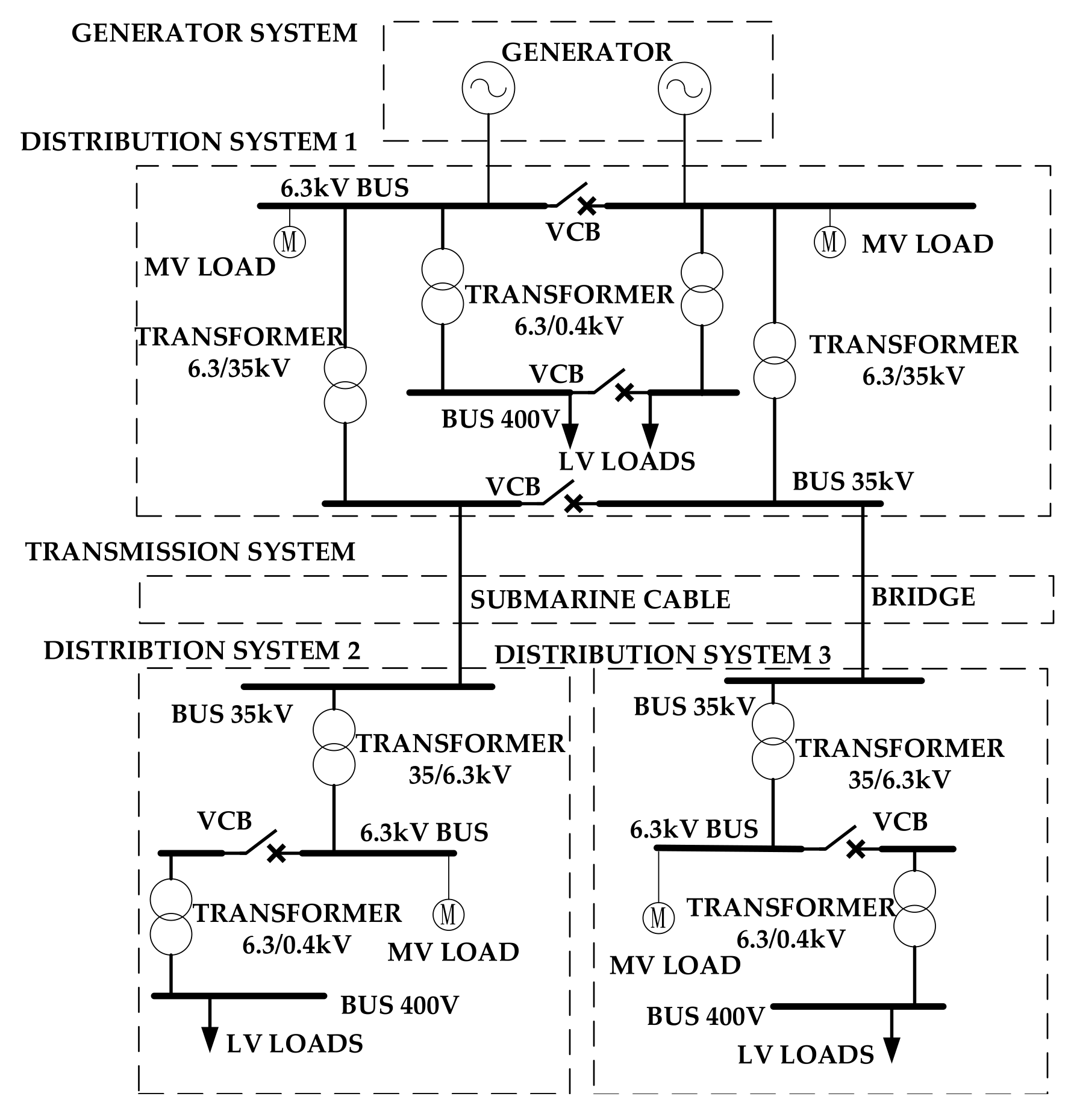
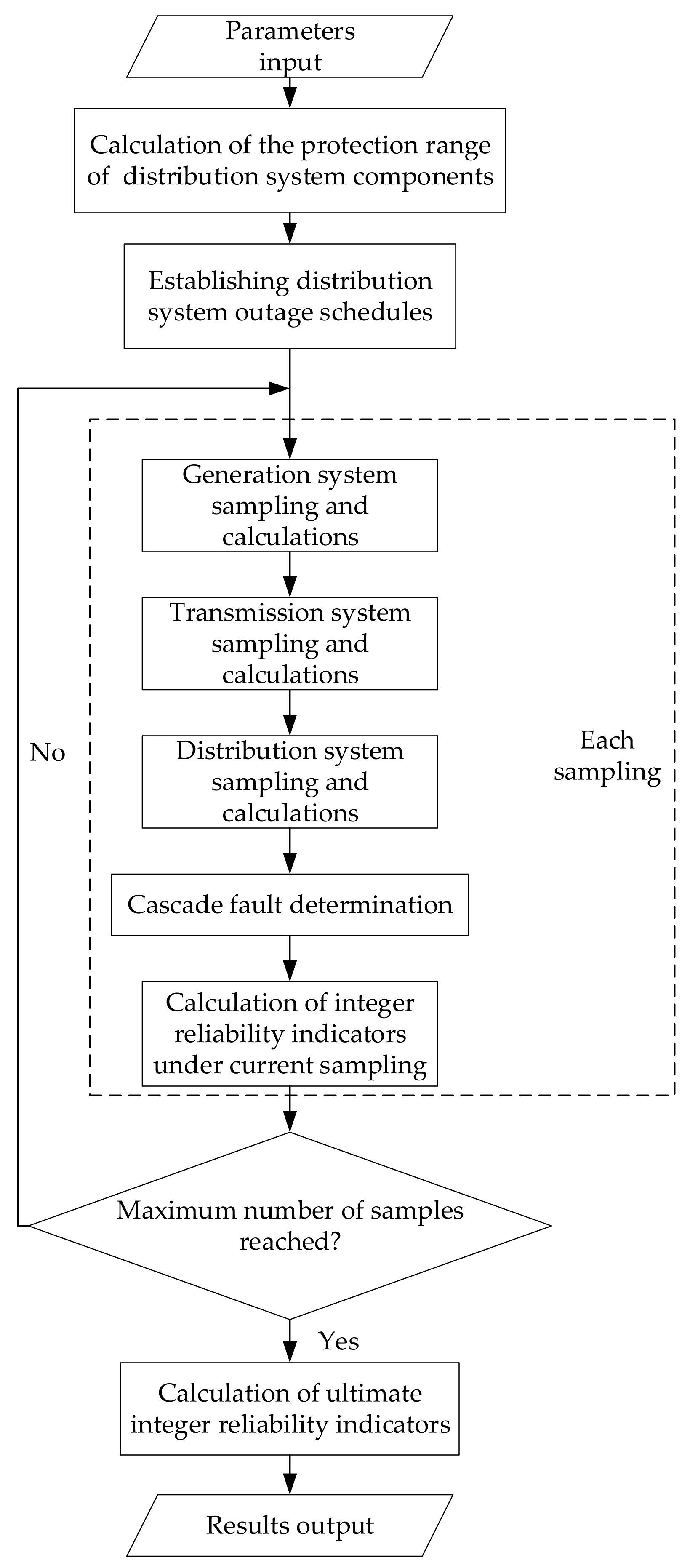
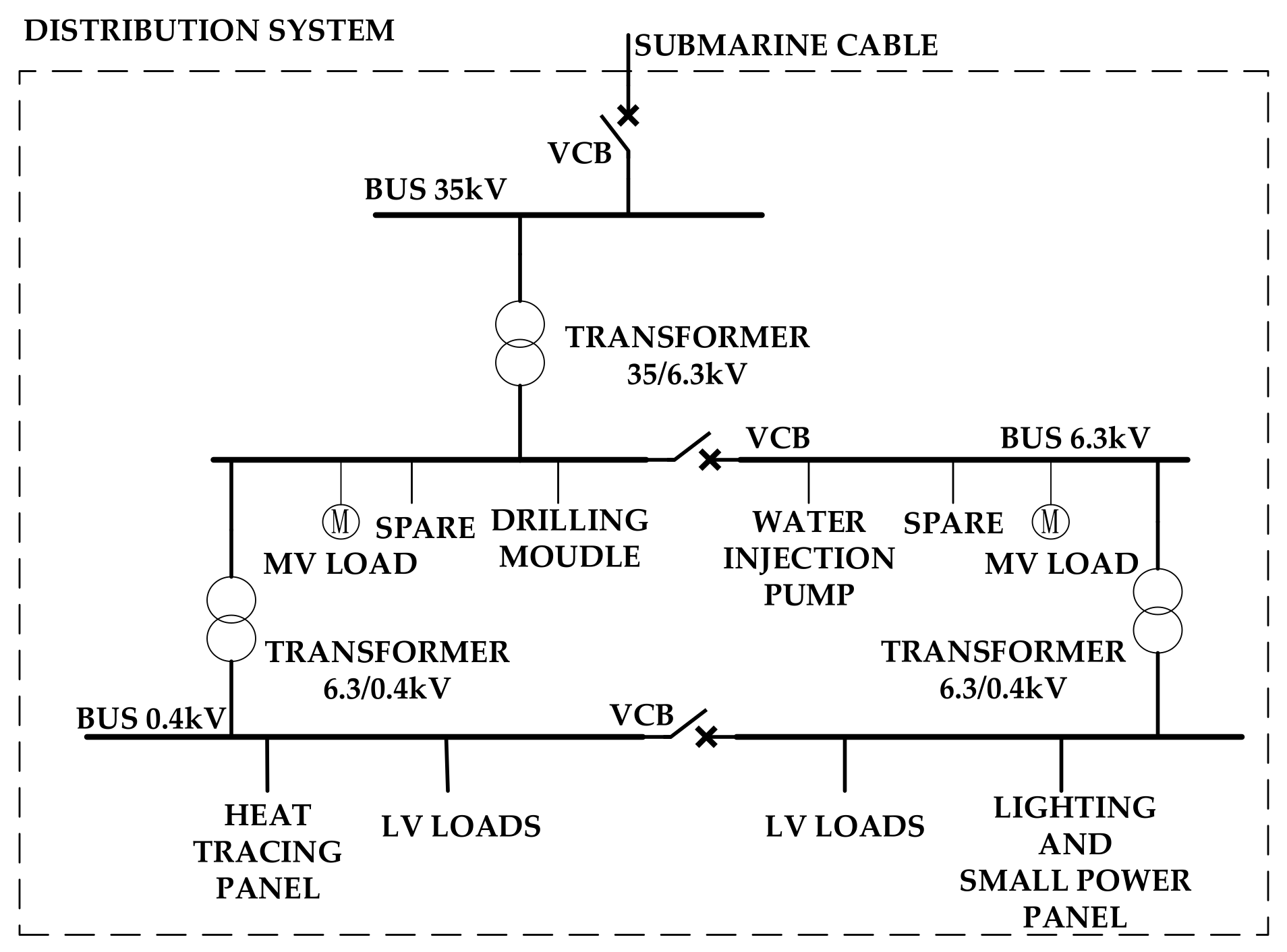
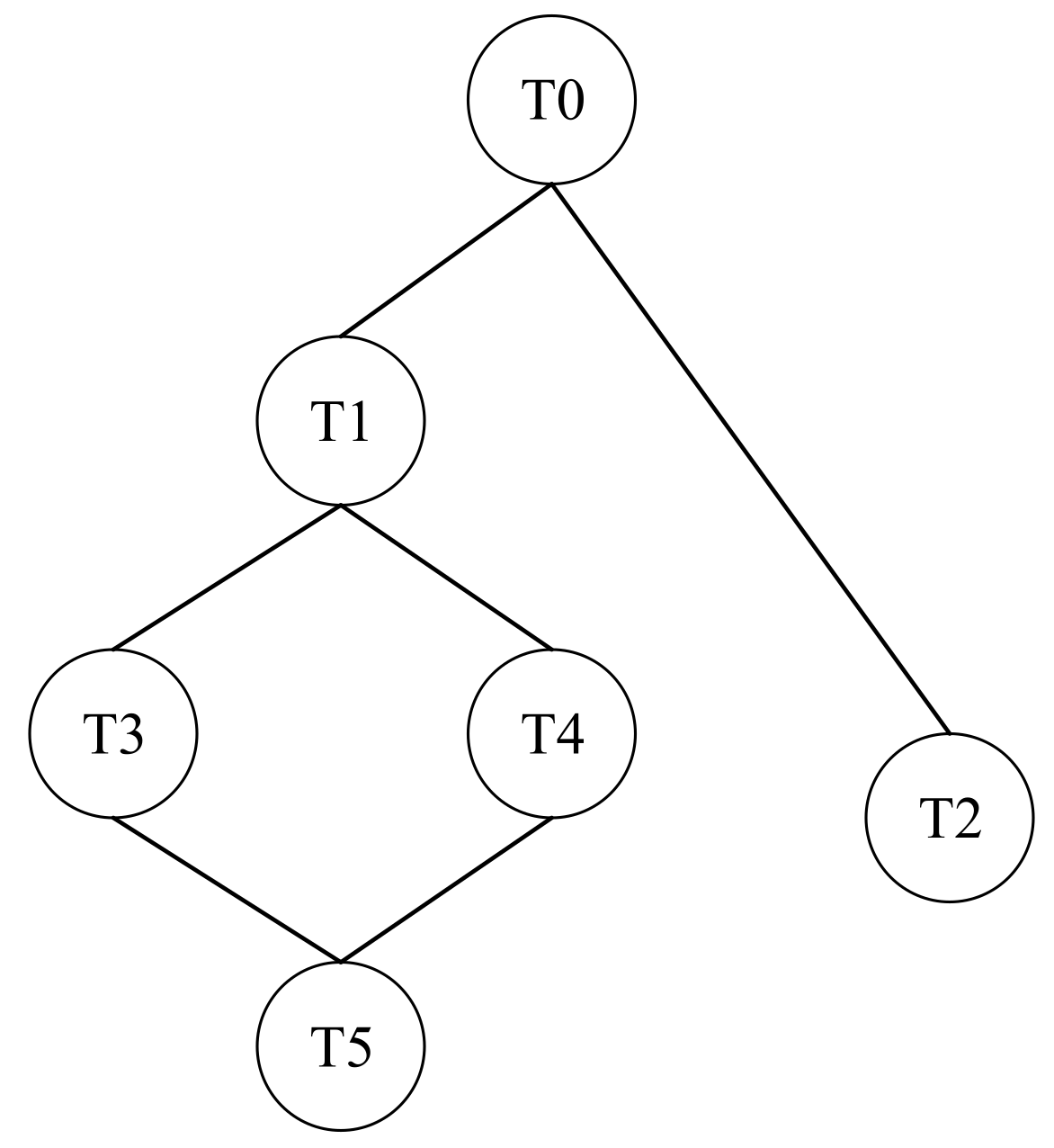
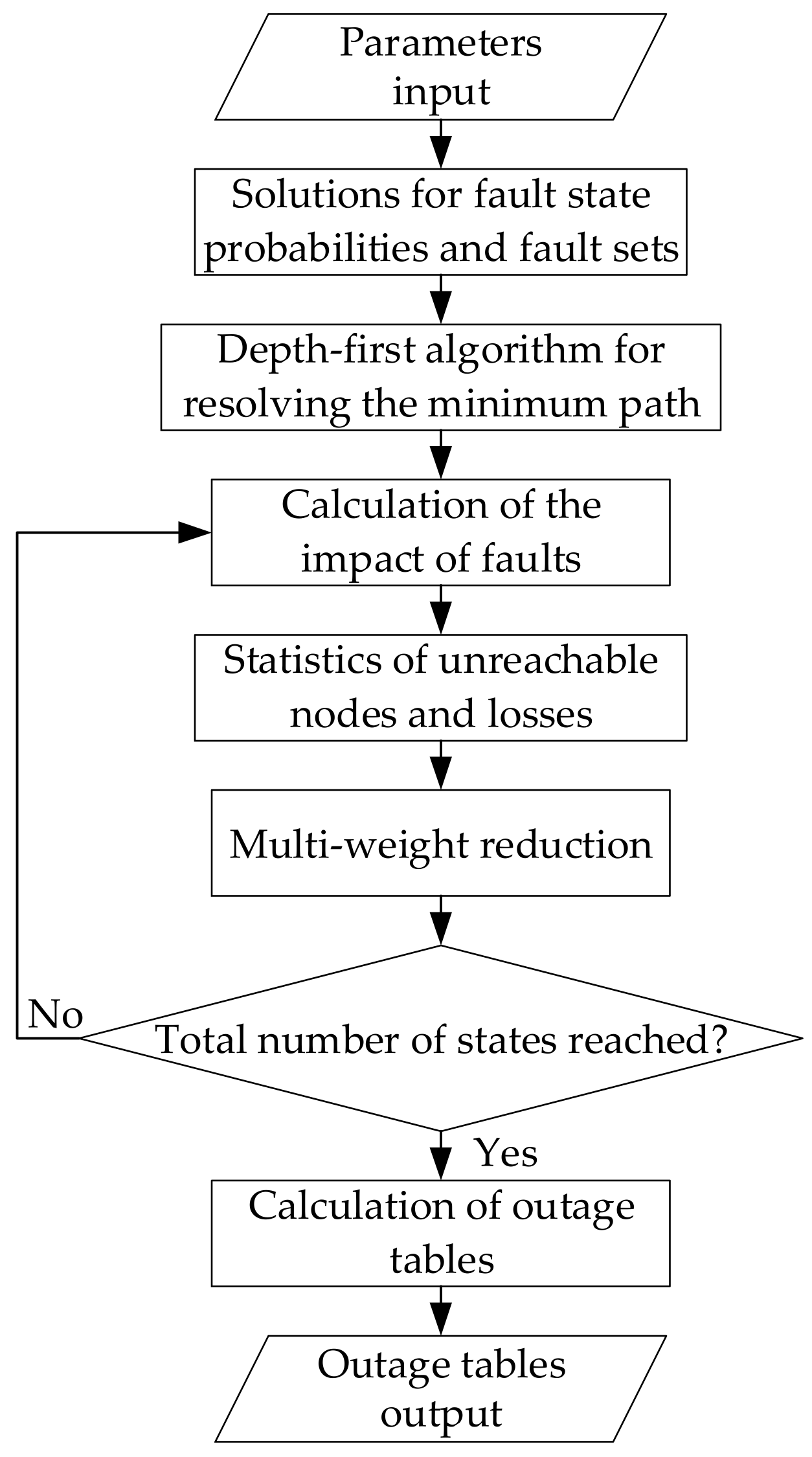

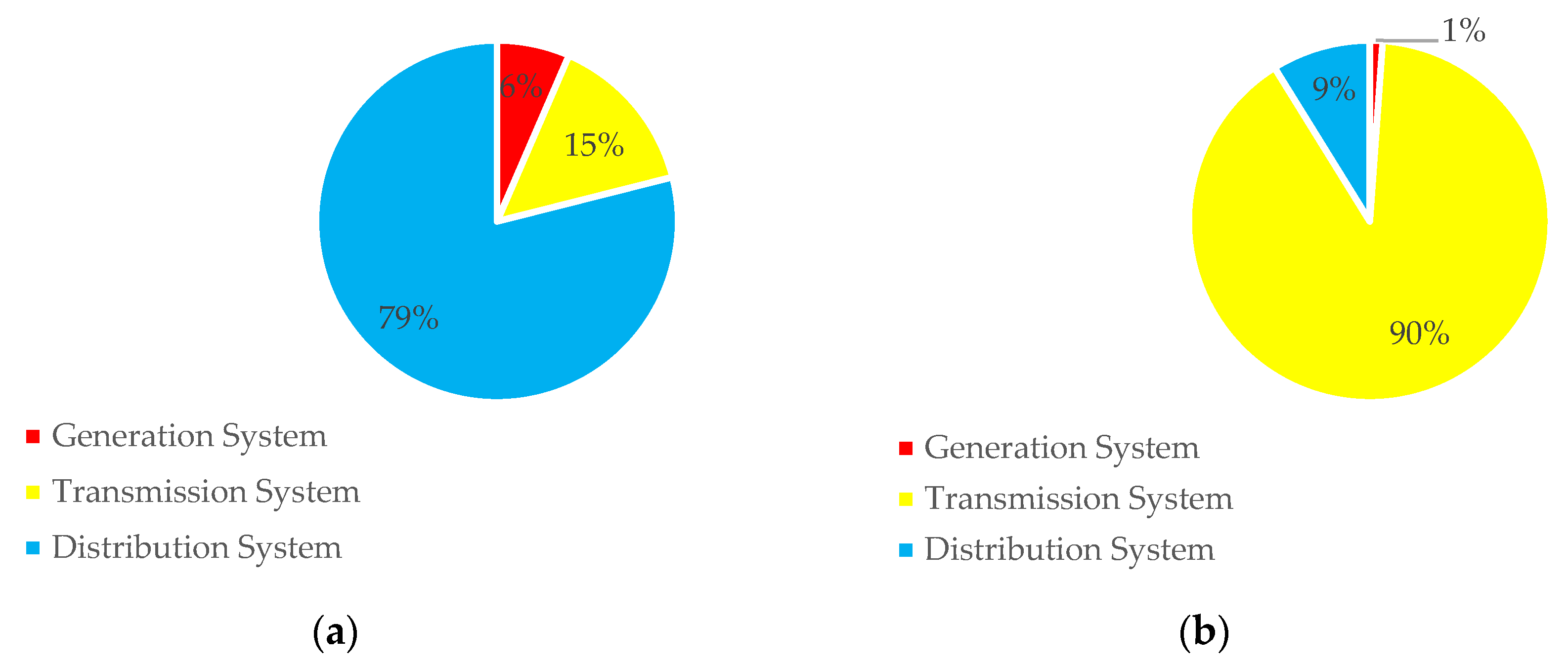
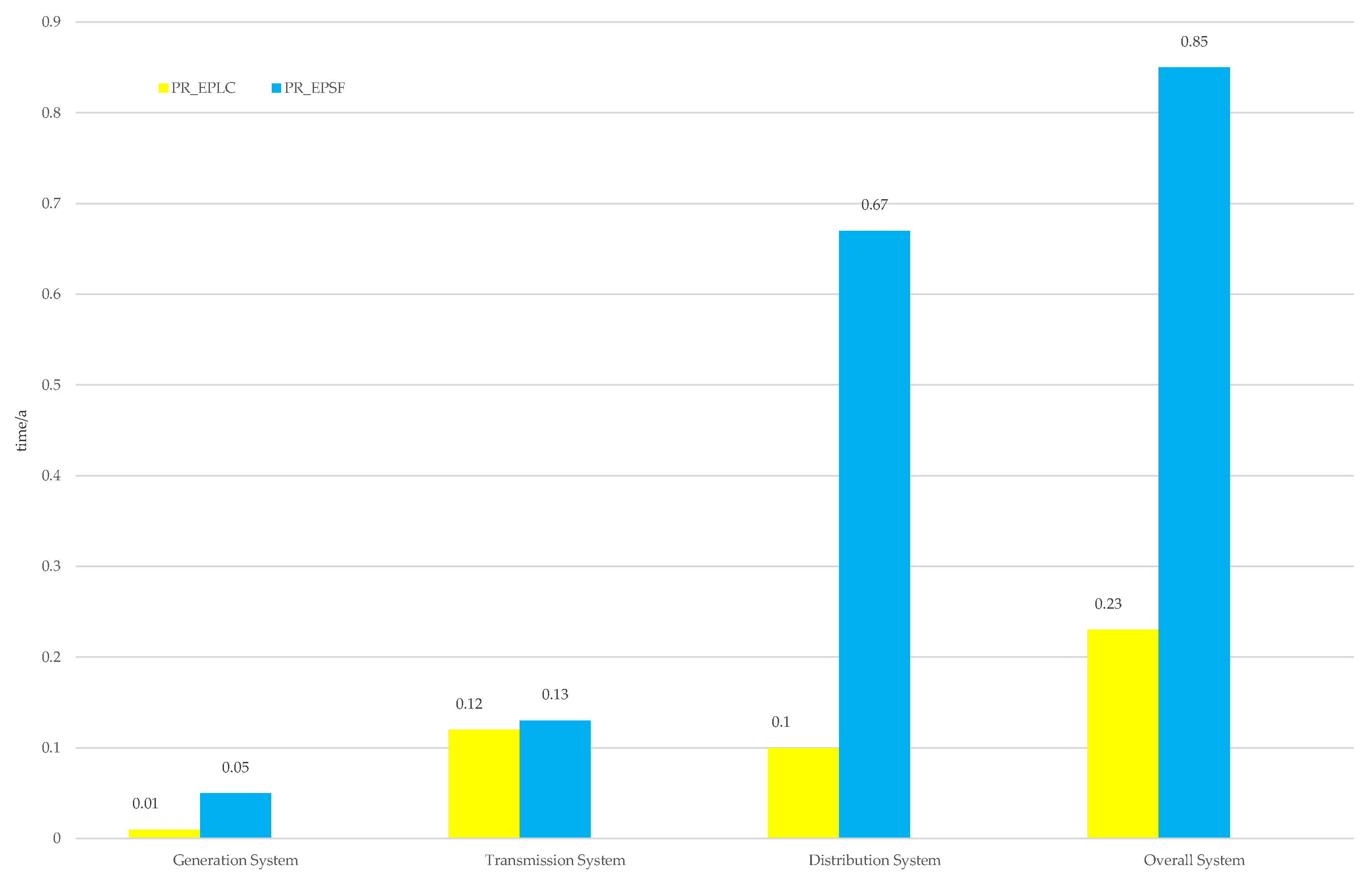
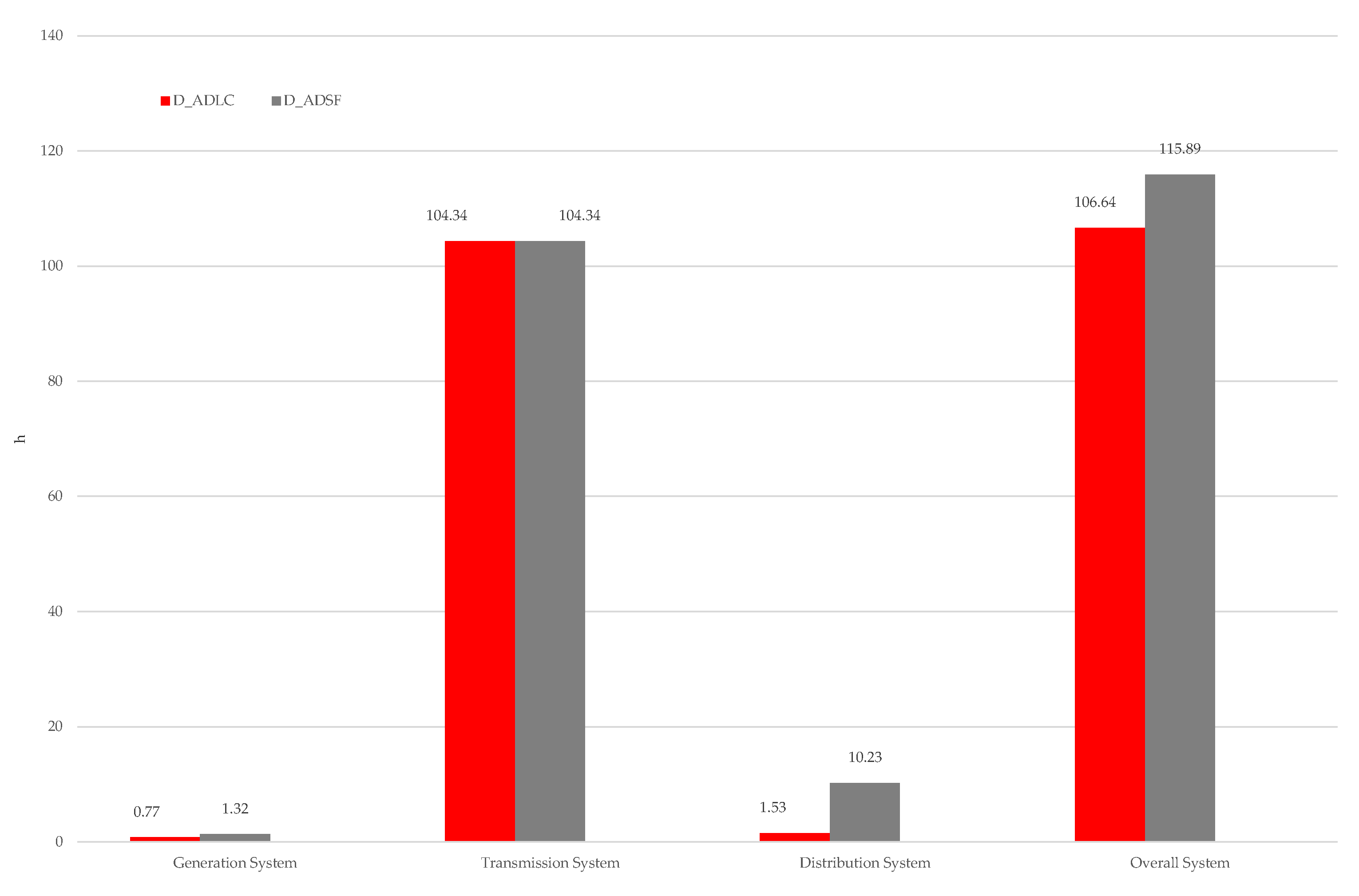
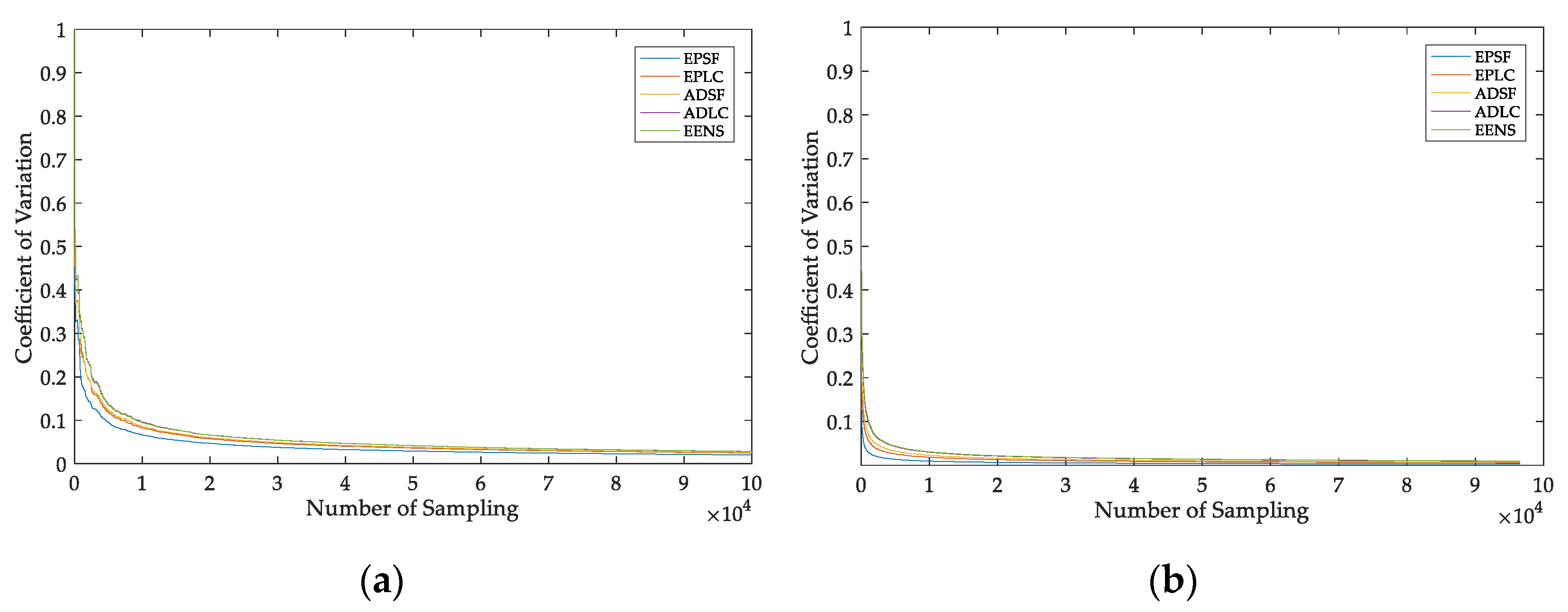

| System Index | Index Meaning | Sample Index | Index Meaning | Calculation |
|---|---|---|---|---|
| Probability of component failure in the system i | This variable indicates whether system i fails in the k-th sampling | |||
| Mean duration of failure of components in the system i | Duration of components of system i in the k-th sampling | |||
| Probability of load cut due to failure of components in the system i | This variable indicates whether system i experienced load shedding in the k-th sampling | |||
| Average load shedding duration caused by component failure in the system i | Duration of load shedding caused by the failure of i system in the k-th sampling | |||
| System loss power expectation in the system i | Power loss value of the k-th sampling in the system i | |||
| System loss energy expectation in the system i | Energy loss value of the k-th sampling in the system i |
| Importance | Equipment Name | Subordinate System |
|---|---|---|
| 1 | Water injection pump | Water injection system |
| 2 | Medium pressure/high pressure compressor, associated gas compressor | Natural gas system |
| 3 | Air compressor, on/off discharge system Crane, air conditioner, etc. | Public system |
| 4 | Electric submersible pump, crude oil export pump, separator, fuel gas system | Main process system |
| 5 | Drilling module, workover rigs | Drilling system |
| Platform Name | Active Load/(MW) | Generation Capacity/(MW) | Platform Name | Active Load/(MW) | Generation Capacity/(MW) |
|---|---|---|---|---|---|
| CEP 1 | 21.401 | 11.974*3 | WHP 2 | 5.786 | 0 |
| CEP 2 | 8.094 | 11.974*3 | WHP 3 | 4.669 | 0 |
| CEP 3 | 25.235 | 11.974*2 | WHP 4 | 14.542 | 0 |
| WHP 1 | 9.321 | 0 | WHP 5 | 3.738 | 0 |
| Element | Failure Rate/(Time∙a−1) | Repair Time/(h) | ||
|---|---|---|---|---|
| Submarine Cable/(km) | L*0.00379 | 26.201*L + 597.75 | ||
| Bridge/(km) | L*0.03 | L*30 | ||
| Element | Failure Rate /(time∙a−1) | Repair Time /(h) | Maintenance Rate /(time∙a−1) | Maintenance Time/(h) |
| Turbine Unit | 2.2 | 22.4 | 3 | 72 |
| Breaker | 0.18 | 24 | 0.2 | 48 |
| Transformer | 0.04 | 200 | 1 | 120 |
| Bus | 0.09 | 6 | 0.1 | 8 |
| State | State Probability | LEEENS/(MWh) | DADSF/(h) | DADLC/(h) |
|---|---|---|---|---|
| 1 | 0.951233 | 0 | 0 | 0 |
| 2 | 0.008792 | 0 | 120 | 0 |
| 3 | 0.008623 | 0 | 48 | 0 |
| 4 | 0.006598 | 0 | 15 | 0 |
| 5 | 0.003887 | 0 | 24 | 0 |
| 6 | 0.002182 | 24.69 | 24 | 24 |
| 7 | 0.002182 | 28.87 | 24 | 24 |
| 8 | 0.002182 | 38.64 | 24 | 24 |
| 9 | 0.002181 | 24.34 | 24 | 24 |
| 10 | 0.002181 | 27.47 | 24 | 24 |
| 11 | 0.002181 | 34.80 | 24 | 24 |
| 12 | 0.001092 | 31.69 | 24 | 24 |
| 13 | 0.001092 | 42.86 | 24 | 24 |
| 14 | 0.001092 | 30.64 | 24 | 24 |
| 15 | 0.001092 | 39.02 | 24 | 24 |
| 16 | 0.000273 | 47.97 | 48 | 48 |
| 17 | 0.000136 | 70.37 | 48 | 48 |
| 18 | 0.000060 | 24.87 | 8 | 8 |
| … | … | … | … | … |
| Index (DC Power Flow) | Overall System Results |
|---|---|
| LEEENS/(MWh) | 980.89 |
| Percentage of Annual Electricity Consumption/(%) | 0.12 |
| ASAI/(%) | 98.49 |
| Index (AC Power Flow) | Overall System Results |
| LEEENS/(MWh) | 1116.50 |
| Percentage of Annual Electricity Consumption/(%) | 0.14 |
| ASAI/(%) | 98.36 |
| Index | Generation System | Transmission System | Distribution System | Overall System |
|---|---|---|---|---|
| PREPSF/(time∙a−1) | 0.05 | 0.13 | 0.67 | 0.85 |
| Percentage/(%) | 6.51 | 14.55 | 78.94 | 100 |
| DADSF/(h) | 1.32 | 104.34 | 10.23 | 115.89 |
| Percentage/(%) | 1.14 | 90.03 | 8.83 | 100 |
| Index | Generation System | Transmission System | Distribution System | Overall System |
|---|---|---|---|---|
| PREPLC/(time∙a−1) | 0.01 | 0.12 | 0.10 | 0.23 |
| Percentage/(%) | 4.91 | 53.09 | 42.01 | 100 |
| DADLC/(h) | 0.77 | 104.34 | 1.53 | 106.64 |
| Percentage/(%) | 0.72 | 97.84 | 1.44 | 100 |
| LEEENS/(MWh) | 4.58 | 1108.24 | 3.68 | 1116.50 |
| Percentage/(%) | 0.41 | 99.26 | 0.33 | 100 |
| Index | DADSF /(h) | DADLC /(h) | LEEENS /(MWh) | Installation Costs /(Million Yuan) | |
|---|---|---|---|---|---|
| Ring Network | |||||
| None | 115.89 | 106.64 | 1116.50 | 0 | |
| 4 km | 128.67 | 63.08 | 922.37 | 4.2 | |
| 13 km | 133.64 | 52.82 | 618.30 | 22.76 | |
| 17.5 km | 137.84 | 50.71 | 783.62 | 30.625 | |
Publisher’s Note: MDPI stays neutral with regard to jurisdictional claims in published maps and institutional affiliations. |
© 2021 by the authors. Licensee MDPI, Basel, Switzerland. This article is an open access article distributed under the terms and conditions of the Creative Commons Attribution (CC BY) license (https://creativecommons.org/licenses/by/4.0/).
Share and Cite
Guan, J.; Du, W.; Wang, X.; Luo, X.; Liu, X.; Li, X. A Reliability Evaluation Method for Independent Small Offshore Electric Systems. Energies 2021, 14, 3035. https://doi.org/10.3390/en14113035
Guan J, Du W, Wang X, Luo X, Liu X, Li X. A Reliability Evaluation Method for Independent Small Offshore Electric Systems. Energies. 2021; 14(11):3035. https://doi.org/10.3390/en14113035
Chicago/Turabian StyleGuan, Jun, Wei Du, Xiuli Wang, Xianjue Luo, Xingyang Liu, and Xue Li. 2021. "A Reliability Evaluation Method for Independent Small Offshore Electric Systems" Energies 14, no. 11: 3035. https://doi.org/10.3390/en14113035
APA StyleGuan, J., Du, W., Wang, X., Luo, X., Liu, X., & Li, X. (2021). A Reliability Evaluation Method for Independent Small Offshore Electric Systems. Energies, 14(11), 3035. https://doi.org/10.3390/en14113035




